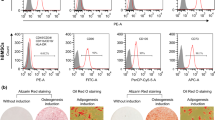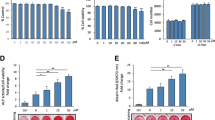Abstract
Summary
Using human mesenchymal stem cells, we identified catechin from a panel of herbal ingredients and Chinese traditional compounds with the strongest osteogenic effects. Catechin increased alkaline phosphatase activity, calcium deposition, and mRNA expression of Runx2 and osteocalcin. We further clarified the signaling pathway that catechin mediated to stimulate osteogenesis.
Introduction
Human mesenchymal stem cells (hMSCs), useful as a species specific cell culture system for studying cell lineage differentiation, were examined as a tool to identify novel herbal ingredients and Chinese traditional compounds for enhancing osteogenesis.
Methods
Immortalized and primary hMSCs were induced in osteogenic induction medium in the presence of a variety of herbal ingredients and Chinese traditional compounds and osteogenic differentiation was evaluated by histochemical assays and quantitative RT-PCR.
Results
Using immortalized hMSCs, we first identified catechin, 18β-glycyrrhetinic acid, baishao, and danggui with osteogenic properties, which enhanced calcium deposition at the dose without significant cytotoxic effects. Primary hMSCs were then applied for confirming the osteogenic effects of catechin, which increased alkaline phosphatase activity, calcium deposition, and mRNA expression of Runx2 and osteocalcin. We further found the extracellular signal-regulated kinase (ERK) pathway was downregulated upon stimulation with catechin. Catechin increased the level and activity of protein phosphatases 2A (PP2A) that dephosphorylates ERK kinase (MEK) and ERK. Further, PP2A inhibitor, okadaic acid, abolished the effect of catechin-mediated inactivation of ERK and stimulation of osteogenesis. The blocking effect of okadaic acid on osteogenesis was further reversed by PD98059, a specific inhibitor of MEK. Co-immunoprecipitation revealed the association of PP2A to both MEK and ERK.
Conclusions
These studies propose catechin enhanced osteogenesis by increasing the PP2A level that inhibits the MEK and ERK signaling in hMSCs. These results prove the concept of using hMSCs as a convenient tool for rapid and consistent screening of the osteogenic herbal ingredients and traditional Chinese compounds.






Similar content being viewed by others
References
Jaworski ZF (1984) Coupling of bone formation to bone resorption: a broader view. Calcif Tissue Int 36:531–535
Hodsman AB, Bauer DC, Dempster DW, Dian L, Hanley DA, Harris ST, Kendler DL, McClung MR, Miller PD, Olszynski WP, Orwoll E, Yuen CK (2005) Parathyroid hormone and teriparatide for the treatment of osteoporosis: a review of the evidence and suggested guidelines for its use. Endocr Rev 26:688–703
Hung SC, Chen NJ, Hsieh SL, Li H, Ma HL, Lo WH (2002) Isolation and characterization of size-sieved stem cells from human bone marrow. Stem Cells 20:249–258
Prockop DJ (1997) Marrow stromal cells as stem cells for nonhematopoietic tissues. Science 276:71–74
Horwitz EM, Prockop DJ, Fitzpatrick LA, Koo WW, Gordon PL, Neel M, Sussman M, Orchard P, Marx JC, Pyeritz RE, Brenner MK (1999) Transplantability and therapeutic effects of bone marrow-derived mesenchymal cells in children with osteogenesis imperfecta. Nat Med 5:309–313
Yang DC, Tsay HJ, Lin SY, Chiou SH, Li MJ, Chang TJ, Hung SC (2008) cAMP/PKA regulates osteogenesis, adipogenesis and ratio of RANKL/OPG mRNA expression in mesenchymal stem cells by suppressing leptin. PLoS ONE 3:e1540
Treiser MD, Yang EH, Gordonov S, Cohen DM, Androulakis IP, Kohn J, Chen CS, Moghe PV Cytoskeleton-based forecasting of stem cell lineage fates. Proc Natl Acad Sci U S A 107:610–615
Zhao Y, Ding S (2007) A high-throughput siRNA library screen identifies osteogenic suppressors in human mesenchymal stem cells. Proc Natl Acad Sci USA 104:9673–9678
Wu X, Ding S, Ding Q, Gray NS, Schultz PG (2002) A small molecule with osteogenesis-inducing activity in multipotent mesenchymal progenitor cells. J Am Chem Soc 124:14520–14521
Wang R, Kong J, Wang D, Lien LL, Lien EJ (2007) A survey of Chinese herbal ingredients with liver protection activities. Chin Med 2:5
Vickers A, Zollman C (1999) ABC of complementary medicine: herbal medicine. Bmj 319:1050–1053
Choi RC, Gao QT, Cheung AW, Zhu JT, Lau FT, Li J, Li WZ, Chu GK, Duan R, Cheung JK, Ding AW, Zhao KJ, Dong TT, Tsim KW (2009) A Chinese Herbal Decoction, Danggui Buxue Tang, Stimulates Proliferation, Differentiation and Gene Expression of Cultured Osteosarcoma Cells: Genomic Approach to Reveal Specific Gene Activation. Evid Based Complement Alternat Med
Nian H, Qin LP, Zhang QY, Zheng HC, Yu Y, Huang BK (2006) Antiosteoporotic activity of Er-Xian Decoction, a traditional Chinese herbal formula, in ovariectomized rats. J Ethnopharmacol 108:96–102
Nian H, Qin LP, Chen WS, Zhang QY, Zheng HC, Wang Y (2006) Protective effect of steroidal saponins from rhizome of Anemarrhena asphodeloides on ovariectomy-induced bone loss in rats. Acta Pharmacol Sin 27:728–734
Song QH, Kobayashi T, Hosoi T, Cyong JC (2003) Effects of traditional Chinese medicines on murine bone metabolism in a microgravity environment. Am J Chin Med 31:739–749
Sakamoto S, Sassa S, Kudo H, Suzuki S, Mitamura T, Shinoda H (2000) Preventive effects of a herbal medicine on bone loss in rats treated with a GnRH agonist. Eur J Endocrinol 143:139–142
Yun JH, Pang EK, Kim CS, Yoo YJ, Cho KS, Chai JK, Kim CK, Choi SH (2004) Inhibitory effects of green tea polyphenol (−)-epigallocatechin gallate on the expression of matrix metalloproteinase-9 and on the formation of osteoclasts. J Periodontal Res 39:300–307
Chen CH, Ho ML, Chang JK, Hung SH, Wang GJ (2005) Green tea catechin enhances osteogenesis in a bone marrow mesenchymal stem cell line. Osteoporos Int 16:2039–2045
Choi JH, Rhee IK, Park KY, Park KY, Kim JK, Rhee SJ (2003) Action of green tea catechin on bone metabolic disorder in chronic cadmium-poisoned rats. Life Sci 73:1479–1489
Osyczka AM, Leboy PS (2005) Bone morphogenetic protein regulation of early osteoblast genes in human marrow stromal cells is mediated by extracellular signal-regulated kinase and phosphatidylinositol 3-kinase signaling. Endocrinology 146:3428–3437
Lund AW, Stegemann JP, Plopper GE (2008) Inhibition of ERK promotes collagen gel compaction and fibrillogenesis to amplify the osteogenesis of human mesenchymal stem cells in three-dimensional, collagen I culture. Stem Cells Dev 18(2):331–342
Higuchi C, Myoui A, Hashimoto N, Kuriyama K, Yoshioka K, Yoshikawa H, Itoh K (2002) Continuous inhibition of MAPK signaling promotes the early osteoblastic differentiation and mineralization of the extracellular matrix. J Bone Miner Res 17:1785–1794
Rodriguez JP, Rios S, Fernandez M, Santibanez JF (2004) Differential activation of ERK1, 2 MAP kinase signaling pathway in mesenchymal stem cell from control and osteoporotic postmenopausal women. J Cell Biochem 92:745–754
Janssens V, Goris J (2001) Protein phosphatase 2A: a highly regulated family of serine/threonine phosphatases implicated in cell growth and signalling. Biochem J 353:417–439
Silverstein AM, Barrow CA, Davis AJ, Mumby MC (2002) Actions of PP2A on the MAP kinase pathway and apoptosis are mediated by distinct regulatory subunits. Proc Natl Acad Sci USA 99:4221–4226
Westermarck J, Hahn WC (2008) Multiple pathways regulated by the tumor suppressor PP2A in transformation. Trends Mol Med 14:152–160
Alessi DR, Gomez N, Moorhead G, Lewis T, Keyse SM, Cohen P (1995) Inactivation of p42 MAP kinase by protein phosphatase 2A and a protein tyrosine phosphatase, but not CL100, in various cell lines. Curr Biol 5:283–295
Zhou B, Wang ZX, Zhao Y, Brautigan DL, Zhang ZY (2002) The specificity of extracellular signal-regulated kinase 2 dephosphorylation by protein phosphatases. J Biol Chem 277:31818–31825
Wang GJ, Tsai TH, Lin LC (2007) Prenylflavonol, acylated flavonol glycosides and related compounds from Epimedium sagittatum. Phytochemistry 68:2455–2464
Hung SC, Yang DM, Chang CF, Lin RJ, Wang JS, Low-Tone Ho L, Yang WK (2004) Immortalization without neoplastic transformation of human mesenchymal stem cells by transduction with HPV16 E6/E7 genes. Int J Cancer 110:313–319
Sekiya I, Larson BL, Smith JR, Pochampally R, Cui JG, Prockop DJ (2002) Expansion of human adult stem cells from bone marrow stroma: conditions that maximize the yields of early progenitors and evaluate their quality. Stem Cells 20:530–541
Vali B, Rao LG, El-Sohemy A (2007) Epigallocatechin-3-gallate increases the formation of mineralized bone nodules by human osteoblast-like cells. J Nutr Biochem 18:341–347
Tae SK, Lee SH, Park JS, Im GI (2006) Mesenchymal stem cells for tissue engineering and regenerative medicine. Biomed Mater 1:63–71
Khan N, Mukhtar H (2007) Tea polyphenols for health promotion. Life Sci 81:519–533
Thomasset SC, Berry DP, Garcea G, Marczylo T, Steward WP, Gescher AJ (2007) Dietary polyphenolic phytochemicals—promising cancer chemopreventive agents in humans? A review of their clinical properties. Int J Cancer 120:451–458
Mumby M (2007) PP2A: unveiling a reluctant tumor suppressor. Cell 130:21–24
Yao CH, Liu BS, Liu CG, Chen YS (2006) Osteogenic potential using a malleable, biodegradable composite added traditional Chinese medicine: in vitro and in vivo Evaluations. Am J Chin Med 34:873–886
Acknowledgment
This study was supported in part by grants from Taipei Veterans General Hospital (V96E2-009); National Science Council (95-2314-B-075-047-MY3, 96-3111-B-010-003, 96-2627-B-010-009) and National Yang-Ming University, Ministry of Education. This work was assisted in part by the Devision of Experimental Surgery of the Department of Surgery, Taipei Veterans General Hospital.
Conflicts of interest
None.
Author information
Authors and Affiliations
Corresponding authors
Additional information
Yu-Jou Wei and Kuo-Shu Tsai have equally contributed to this article.
Electronic supplementary material
Below is the link to the electronic supplementary material.
Supplementary Fig. 1
Flow cytometric analysis of the surface markers in immortalized KP-hMSCs. Cells were reacted with FITC-conjugated antibodies (solid line) or isotype IgG antibodies (dotted line; PDF 128 kb)
Supplementary Fig. 2
Catechin enhances expression of osteogenic genes during differentiation. RT-PCR analysis for mRNA expression of Runx2, Col1A1, bone sialoprotein (BSP), osteopontin (OSP), and osteocalcin (Oc) at day 3 of osteogenic induction (PDF 84 kb)
Supplemetary Table 1
Summary of effects of each herbal ingredient and Chinese preparation on osteogenesis as analyzed by Alizarin Red S staining in primary MSCs. Data were shown as percentage (mean ± SD, n = 3) in comparison with the vehicle control (XLS 24 kb)
Rights and permissions
About this article
Cite this article
Wei, Y.J., Tsai, K.S., Lin, L.C. et al. Catechin stimulates osteogenesis by enhancing PP2A activity in human mesenchymal stem cells. Osteoporos Int 22, 1469–1479 (2011). https://doi.org/10.1007/s00198-010-1352-9
Received:
Accepted:
Published:
Issue Date:
DOI: https://doi.org/10.1007/s00198-010-1352-9




